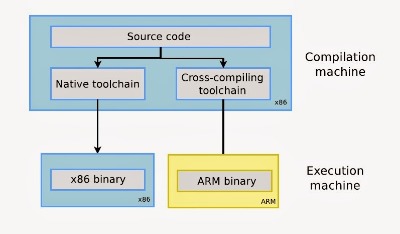Crafting a Comprehensive White Paper on Cross-Compilation Tools and Systems for Embedded Linux
Introduction
Cross-compilation is a fundamental technique in embedded systems development, allowing the compilation of software for a target architecture on a different host system. This white paper delves into the essential tools, systems, and methodologies employed in cross-compilation for Embedded Linux systems.
Understanding Cross-Compilation
- Host System: The system on which the cross-compilation tools are installed and executed.
- Target System: The embedded device where the compiled software will run.
Key Cross-Compilation Tools
- Cross-Compiler:
- A compiler specifically designed to generate code for a target architecture different from the host.
- Popular Cross-Compilers:
- GCC (GNU Compiler Collection): A versatile compiler suite supporting numerous architectures and languages.
- Clang: A modern C, C++, Objective-C, and Objective-C++ compiler.
- Toolchains: Pre-built packages containing cross-compilers, libraries, and other tools for specific target architectures.
- Cross-Assembler:
- Assembles assembly code for the target architecture.
- Linker:
- Links object files generated by the compiler and assembler to create an executable file.
- Debugger:
- Enables debugging of software running on the target system from the host.
- Popular Cross-Debuggers:
- GDB (GNU Debugger): A powerful debugger for both host and target systems.
- QEMU: A versatile emulator that can be used for debugging.
Cross-Compilation Environments
- Buildroot:
- A flexible framework for building embedded Linux systems.
- Enables customization of the Linux kernel, toolchain, and user-space applications.
- OpenEmbedded:
- A large-scale, open-source project providing a comprehensive set of tools and libraries for building embedded Linux systems.
- Yocto Project:
- A collaborative open-source project that offers a flexible framework for creating custom Linux-based systems.
Challenges and Best Practices
- Toolchain Setup:
- Careful configuration of the toolchain is crucial to ensure compatibility with the target hardware.
- Consider using pre-built toolchains provided by vendors or communities.
- Library and Header Management:
- Manage dependencies and provide necessary libraries for the target system.
- Use package managers like opkg or ipk to install libraries on the target.
- Debugging and Testing:
- Utilize remote debugging techniques to analyze issues on the target system.
- Employ effective testing strategies to ensure software quality.
- Security Considerations:
- Address security vulnerabilities in the toolchain and target system.
- Keep software up-to-date and apply security patches.
References
- Books:
- "Embedded Linux Primer" by Christopher Hall
- "Building Embedded Linux Systems" by Karim Yaghmour
- Research Papers:
- [Cite specific papers on cross-compilation techniques and challenges]
- Websites:
- Buildroot: https://openembedded.org/
- Yocto Project:
- Research Groups:
- [List relevant research groups and universities working on embedded systems]
Conclusion
Cross-compilation is an indispensable technique for developing efficient and reliable Embedded Linux systems. By mastering the tools, environments, and best practices outlined in this white paper, developers can effectively build and deploy software for a wide range of embedded devices.
Additional Considerations
- Containerization: Explore containerization technologies like Docker and LXC to package and deploy applications on embedded systems.
- Cloud-Native Development: Leverage cloud-native development principles to build and deploy scalable embedded systems.
- AI and Machine Learning: Consider the integration of AI and ML capabilities into embedded systems, requiring specialized toolchains and frameworks.
By staying informed about the latest advancements in cross-compilation and embedded systems development, you can create innovative and robust solutions for the future.
Note: For a more in-depth and tailored white paper, consider consulting with experts in the field or conducting specific research on your target architecture and use case.
Would you like to delve deeper into a specific aspect of cross-compilation, such as toolchain setup, debugging techniques, or security considerations? Contact ias-research.com



